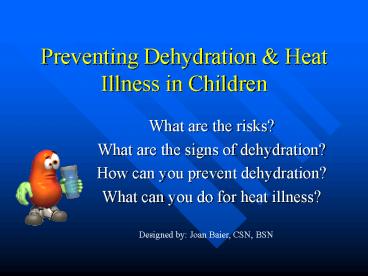Preventing Dehydration - PowerPoint PPT Presentation
1 / 10
Title:
Preventing Dehydration
Description:
Heat Exhaustion and Heat Stroke. Heat exhaustion should be treated the same way ... Heat stroke is ALWAYS an emergency and requires immediate medical attention! ... – PowerPoint PPT presentation
Number of Views:1349
Avg rating:3.0/5.0
Title: Preventing Dehydration
1
Preventing Dehydration Heat Illness in Children
- What are the risks?
- What are the signs of dehydration?
- How can you prevent dehydration?
- What can you do for heat illness?
Designed by Joan Baier, CSN, BSN
2
What are the risk factors for Dehydration?
- Prolonged exposure to high temperatures.
- Prolonged exposure to direct sun.
- Prolonged exposure to high humidity.
- Insufficient rest.
- Insufficient fluid intake.
3
Early Signs of Dehydration
- Fatigue
- Thirst
- Dry lips and tongue
- Lack of energy
- Feeling overheated
4
Types of Heat Illness Caused by Untreated
Dehydration
- Heat cramps Painful cramps of the abdominal
muscles, arms, or legs. - Heat exhaustion Dizziness, nausea, vomiting,
headaches, weakness, muscle pain, sometimes
unconsciousness. - Heat Stroke A temperature of 104F or higher
severe symptoms including nausea vomiting,
seizures, disorientation or delirium, lack of
sweating, shortness of breath, unconsciousness,
coma.
5
Help your Child Prevent Dehydration
- Drink cool water healthy sports drinks early
often. - Be fully hydrated BEFORE going out to play or
practice. - During play make sure your child takes regular
breaks to drink fluid. - Slowly build up your childs fitness ability
to handle the heat. Fitter children will start
to sweat after beginning to exercise thats a
good thing!
6
Facts About Dehydration
- Dehydration is cumulative, it builds up over
time. For example if your child is 1 or 2
dehydrated on Monday doesnt drink enough
fluids that night, then gets 1 or 2 dehydrated
on Tuesday, your child will be 3 or 4
dehydrated at the end of the day Tuesday. - Dehydration may be gradually developing but it
doesnt show up for several days. - Monitor your childs hydration by weighing your
child before after practice. If his weight
drops, hes not drinking enough during his
workout. - If your childs urine is dark in color, rather
than clear or light yellow, your child may
becoming dehydrated.
7
Helping a Child With Heat Illness
- Get the child out of the sun into a cool, shaded,
comfortable place. - Have the child drink plenty of cool fluids
(caffeine free). - Take any excess layers of clothing or bulky
equipment off. - Place cool wet cloths on overheated skin.
- To relieve muscle cramps caused by heat illness,
gently stretch the affected muscle.
8
Heat Exhaustion and Heat Stroke
- Heat exhaustion should be treated the same way as
heat illness. BUT, the child should NOT be
allowed to play again that same day! - Heat stroke is ALWAYS an emergency and requires
immediate medical attention!
9
Risk Factors that Increase a Childs Chance of
Getting Dehydration or Heat Illness
- A previous episode of dehydration or heat illness
put a child at greater risk. - Obesity
- Recent illness (especially if the child has been
vomiting or has had diarrhea). - Use of antihistamines or diuretics.
- Not being used to the hot weather
- Exercising beyond their level of fitness.
10
When is it Too Hot for a Child to Play or
Practice Outside?
- The National Athletic Trainers Association
(NATA) offers a parents and coaches guide of a
heat-index chart recommends when outdoor
practice games should be cancelled due to heat. - Click here to see the guide provided by NATA.

